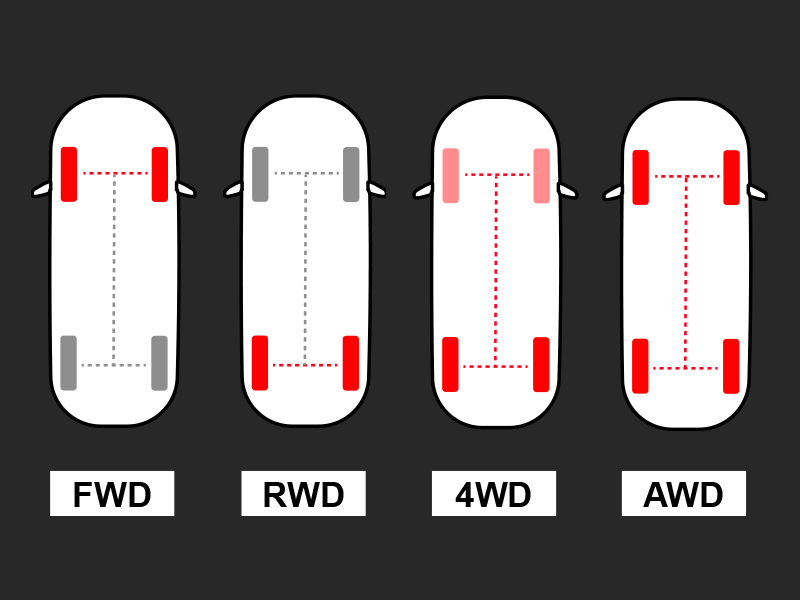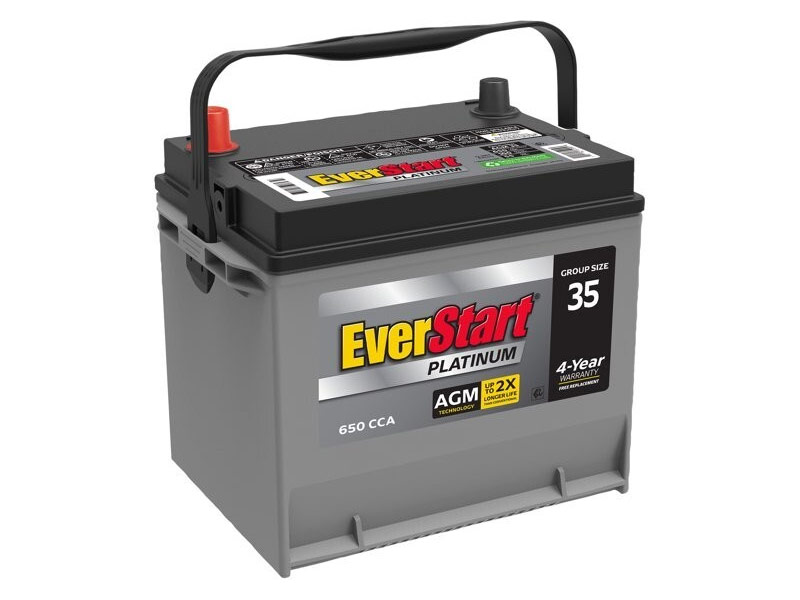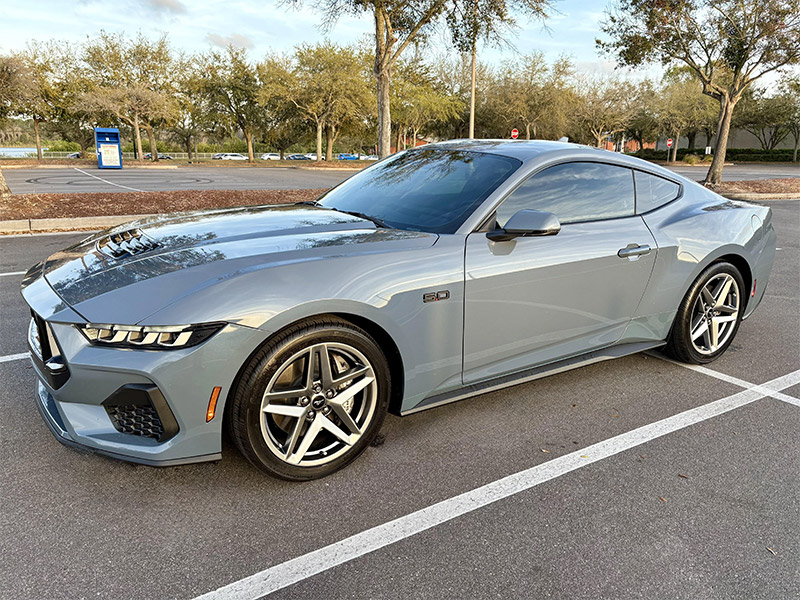
When it comes to vehicles, the drivetrain plays a crucial role in determining how power from the engine is delivered to the wheels. Different drivetrain configurations are designed to optimize various aspects of performance, handling, and traction depending on the vehicle’s intended use. The four most common types of drivetrains are Front-Wheel Drive (FWD), Rear-Wheel Drive (RWD), All-Wheel Drive (AWD), and Four-Wheel Drive (4WD). Each has its unique advantages and trade-offs, making them better suited for specific driving conditions and vehicle types.
This article will explain the key characteristics, strengths, and weaknesses of each drivetrain type, helping you understand their differences and decide which one best fits your needs.
1. Front-Wheel Drive (FWD)
Front-Wheel Drive (FWD) is one of the most common drivetrain setups in modern cars, particularly in compact and mid-size vehicles. In this configuration, the engine’s power is transmitted to the front wheels, which are also responsible for steering the vehicle.
Characteristics of FWD:
- The engine, transmission, and differential are typically combined into a single unit mounted at the front of the vehicle.
- Power is sent directly to the front wheels through a transaxle, simplifying the design and reducing weight.
Advantages of FWD:
- Fuel efficiency: FWD vehicles tend to be lighter and more fuel-efficient due to their simpler mechanical setup. The reduced weight helps improve gas mileage.
- Cost-effective: FWD systems are generally less expensive to manufacture and repair, making them more affordable for consumers.
- Better traction in poor weather: Since the engine weight is over the front wheels, FWD vehicles offer improved traction in wet, snowy, or icy conditions compared to RWD cars.
Disadvantages of FWD:
- Understeer: When pushed hard, especially in high-speed cornering, FWD vehicles are more likely to experience understeer, where the front wheels lose grip and cause the car to drift outward from the turn.
- Limited performance: FWD vehicles are not ideal for high-performance applications. Their weight distribution and handling dynamics can’t match the balanced feel of RWD or AWD cars.
Ideal for:
- Daily driving in urban and suburban environments.
- Drivers who prioritize fuel efficiency, affordability, and good traction in slippery conditions.
2. Rear-Wheel Drive (RWD)
Rear-Wheel Drive (RWD) is commonly found in sports cars, trucks, and luxury sedans. In this layout, the engine sends power to the rear wheels, while the front wheels handle the steering. This separation of power and steering duties provides better overall balance and improved performance in certain conditions.
Characteristics of RWD:
- The engine’s power is sent to the rear wheels through a driveshaft connected to a differential at the rear of the vehicle.
- Weight distribution tends to be more balanced, especially in sports cars, improving handling and acceleration.
Advantages of RWD:
- Better handling and balance: With the engine in the front and power being delivered to the rear, RWD vehicles offer superior weight distribution and a more dynamic driving experience. This makes them ideal for spirited driving and cornering.
- Increased performance: RWD is better suited for high-performance applications since it provides better traction during acceleration. The rear wheels “push” the car forward, making it easier to manage torque and power delivery.
- Towing and payload capacity: RWD is typically the preferred drivetrain in trucks and heavy-duty vehicles because it offers better weight distribution and traction when carrying heavy loads.
Disadvantages of RWD:
- Poor traction in bad weather: Without the weight of the engine over the rear wheels, RWD vehicles struggle with traction in wet, snowy, or icy conditions. This makes them less ideal for regions with frequent poor weather.
- More expensive: RWD vehicles tend to be more expensive to manufacture due to their more complex drivetrain and components.
Ideal for:
- Sports cars and performance vehicles.
- Drivers looking for a more engaging driving experience or those who need towing capabilities.
3. All-Wheel Drive (AWD)
All-Wheel Drive (AWD) is a drivetrain system that distributes power to all four wheels automatically, depending on road conditions and the driver’s needs. AWD is often found in crossovers, SUVs, and some high-performance cars. It’s known for its versatility, offering improved traction in various driving environments.
Characteristics of AWD:
- Power is sent to all four wheels through a center differential that splits torque between the front and rear wheels.
- AWD systems can be either full-time, where power is always sent to all four wheels, or part-time, where the vehicle operates in FWD or RWD most of the time but engages AWD when necessary.
Advantages of AWD:
- Improved traction in diverse conditions: AWD systems excel in situations with low traction, such as rain, snow, gravel, or dirt. This makes AWD vehicles more capable in inclement weather or light off-road driving.
- Automatic adjustment: AWD systems adjust the distribution of power between the front and rear wheels without driver intervention, making them user-friendly and adaptable to changing road conditions.
Disadvantages of AWD:
- Reduced fuel efficiency: AWD systems add weight and complexity to a vehicle, leading to slightly reduced fuel efficiency compared to FWD or RWD models.
- Higher cost: AWD vehicles tend to be more expensive due to the additional drivetrain components and technology involved.
Ideal for:
- Drivers who frequently encounter varying road conditions, such as snow, rain, or light off-road driving.
- Those seeking additional stability and traction without manually engaging the system.
4. Four-Wheel Drive (4WD)
Four-Wheel Drive (4WD) is often found in trucks and off-road vehicles and is designed for extreme off-road conditions. Unlike AWD, 4WD systems allow the driver to manually engage or disengage power to all four wheels, offering more control in challenging environments.
Characteristics of 4WD:
- 4WD systems typically come with high and low gearing options, allowing drivers to switch between two-wheel drive and four-wheel drive as needed. The low-range gears provide additional torque for extreme off-road conditions like climbing steep hills or navigating rocky terrain.
- Many 4WD systems feature a locking differential to ensure that both front and rear wheels receive equal power when engaged.
Advantages of 4WD:
- Unmatched off-road capability: 4WD systems are built for tough, uneven terrains, making them ideal for off-road enthusiasts or those who work in industries like construction, agriculture, or forestry.
- Selectable modes: Drivers can choose between different driving modes, such as 2WD, 4WD High, or 4WD Low, giving them more control over how the vehicle handles in different conditions.
Disadvantages of 4WD:
- Heavier and less efficient: 4WD vehicles are typically heavier and less fuel-efficient compared to their AWD or 2WD counterparts due to the extra components involved in the drivetrain.
- Not necessary for everyday driving: For most drivers, especially those who spend most of their time on paved roads, 4WD can be overkill, offering more capability than they’ll ever use.
Ideal for:
- Off-road driving and extreme terrain.
- Drivers who need extra power and control in rugged environments or heavy-duty applications.
Conclusion
Each drivetrain type offers distinct advantages and trade-offs, making them better suited for specific driving conditions and vehicle uses. FWD is ideal for everyday urban driving, offering simplicity and fuel efficiency, while RWD shines in performance and towing applications. AWD provides enhanced traction and stability in varying conditions, and 4WD is the go-to option for off-road enthusiasts and heavy-duty trucks.
When choosing a vehicle, it’s essential to consider your driving needs, typical road conditions, and whether you prioritize performance, fuel efficiency, or off-road capability. Understanding these drivetrain options will help you make an informed decision that suits your lifestyle and driving preferences.

